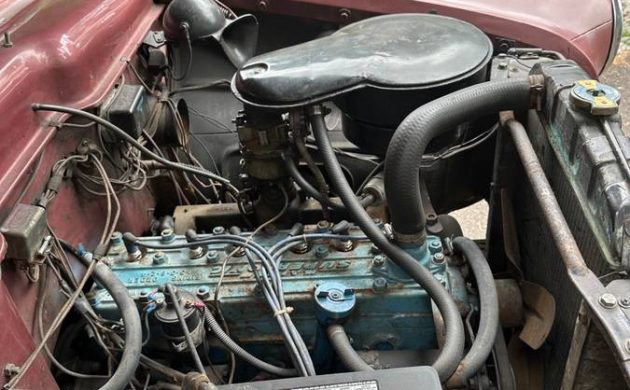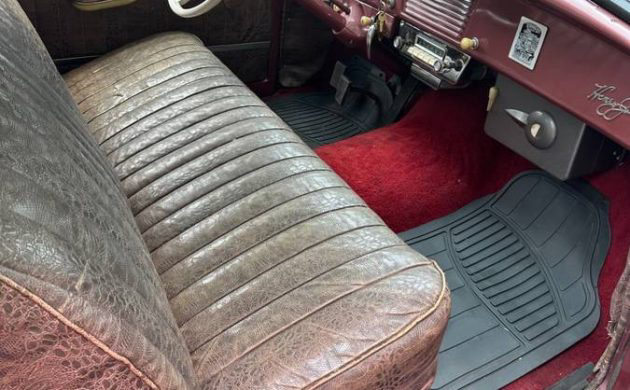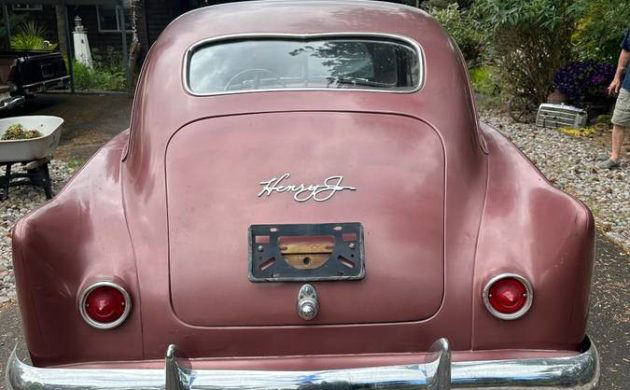Alligator Upholstery! 1951 Henry J Sedan
Like Powel Crosley, Henry Kaiser was a successful industrialist with a long list of accomplishments to his name – but one abiding objective that neither achieved until late in his career: each man yearned to make cars. For Kaiser, the path would emerge from a partnership with Joseph Frazer. The two men joined forces in 1945, hoping to capitalize on America’s post-war boom in automobile sales. But their efforts were hampered first by an unorganized approach to product development, then by dissipating finances, and finally, personal animosity. The company produced its first car in 1946, but by 1951, Frazer had left. Limping into the new decade, Kaiser used an enormous government loan to fulfill his dream of making a “worker’s car” – the Henry J. Situated on a 100″ chassis, the little sedan received a Willys engine. (Anyone know what kit car commonly used a Henry J. chassis?) Very early cars had no trunk lid and the rear windows were fixed. This example, advertised here on craigslist, came along later, so at least it has a trunk lid. The price is $14,900, and it’s located in Longview, Washington. T.J. sent along this tip – thank T.J.!
Kaiser, in his zeal to keep costs low and as a matter of convenience, contracted with Continental to supply engines for his earlier cars. These engines were nothing special and if it weren’t for the fervor of a populace just released from the poverty of war, Kaiser’s cars would have had a much more difficult time gaining market share. Not allowed to learn the lesson of the consequences of a poor powerplant, Kaiser chose the Willys-Overland 134 cu. in. four-cylinder, making all of 68 hp, for his compact car. The penurious car hit the market while the Nash Rambler was selling briskly, but the tide was about to turn. Almost overnight, people wanted larger cars. As sensible and inexpensive as the Henry J was, it was not a successful venture. This example has a column-shift three-speed manual and is said to run and drive well.
The distinctive “dragon” or alligator vinyl upholstery is in great shape, if a bit faded. To keep costs low, the Henry J eschewed interior frills – there is no glove compartment, and base models didn’t have sun visors or armrests. Warning lights supplant gauges for amps and oil pressure. The windshield was split to accommodate flat glass. Despite its poverty airs, the Henry J was priced only a few dollars less than a better-appointed Chevy.
As if all this were not enough, the styling was a sore subject internally. Dutch Darrin was working with Kaiser at the time, but not happily. His original design for a compact car was turned down in favor of a cheap prototype made by American Metal Products. Darrin contributed the tiny fins and the “Darrin dip” at the B-pillar. After a flush of sales in its launch year, it was all downhill, with production exceeding demand routinely. Kaiser bought Willys-Overland in 1954, remaining relevant in the automotive market for several years thereafter, and the Henry J went on to foster hot rod dreams in all four corners of the country. This original example deserves a sympathetic home that will maintain its survivor status.
Auctions Ending Soon
 2002 Subaru Impreza WRXBid Now2 days$333
2002 Subaru Impreza WRXBid Now2 days$333
 1975 Chevrolet Corvette ConvertibleBid Now2 days$4,000
1975 Chevrolet Corvette ConvertibleBid Now2 days$4,000
 1964 Ford F-100 Camper CustomBid Now2 days$2,000
1964 Ford F-100 Camper CustomBid Now2 days$2,000
 2006 Jeep Wrangler SportBid Now4 days$10,500
2006 Jeep Wrangler SportBid Now4 days$10,500
 1974 Datsun 260ZBid Now6 days$460
1974 Datsun 260ZBid Now6 days$460





Comments
Wow! By all rights, the Henry J and lesser known Allstate, should have been a hit. This car has much more than a trunk option. Radio, sun visors, glove box,( not shown), arm rests, heater, maybe O/D, all extra. You didn’t get much for the $1365 list price( Allstates a bit higher). Henry Js were the epitome of simple car ownership. Allstate’s were a bit fancier from the get go, but Henry Js were strictly focused on the Joe Lunchpails of this country. Long trips were simply unheard of for most, and city transport was most important. All cars generally used the same mechanical parts then, so the Henry J was adequate for the time. Turns out, the Henry J was a flop, and I’m not sure why. The Allstate failed because Sears had no real dealer network, and people just didn’t want to buy a car from Sears, apparently.
Again, like all these, I can see it now, “oh, what a cute little car, oops, wait a minute, it’s a stick”, as they climb back into their jellybean. How this escaped being turned into a gasser, is a mystery we’ll never know.
Michelle, this particular HJ appears to have a six-cylinder engine, which would be the 161 cubic-inch L-head from Willys. The “four,” I believe, was based on the “Go Devil” Jeep unit. The trim and accessories were slightly fancier on the sixes.
Interestingly, the Kaiser Darrin used the 161 engine (and, I think, the HJ chassis. A friend’s father had a Henry J chassis, and purchased a Devin body for it. So far as I know, it was one of the many, many “sports car” projects that never got completed.
My sole quibble with your excellent write-up is that the Dragon Vinyl upholstery material was never called “alligator” officially.
Not a fan of the color, but am a fan of HJs. This one looks pretty nice.
Thank you, RayT. I went down a rabbit hole on this one which frankly distracted me from the actual car. I was wrapped up in the Kaiser/Frazer relationship and history which was pretty interesting, salted up as it was with that character Dutch Darrin. I don’t think those three guys could be in a room together without someone starting a fight.
Kaiser was a “pedal to the metal” outsider, while Frazer was a Detroit insider. Kaiser’s tendency to charge onward despite Frazer’s well-considered advice eventually broke them up. Frazer got the last laugh as Kaiser misread the market and overestimated his abilities in the process of bringing out the Henry J.
While it wasn’t a bad car, it suffered the same fate as the Hudson Jet would later. To make any money of the car it was priced too high, as the article says. Why by a cheap small car when for a few dollars more you could have a Ford or Chevy? Strangely enough, the Henry J was raced on stock car oval tracks well into the 60s since it had very good power to weight (it wasn’t heavy). And, some have had supercharged big block Chevy drive trains installed as wild customs. I saw one at a car show with a Merlin 500 in it.
Well not sure why the HJK version didn’t make it but it was a labeling error for the Allstate. Sears should have called it the Craftsman (Craftperson to be politically correct in today’s terminology) and removed the back seat, put pull out shelves accessible via the trunk and call it the self propelling, mobile toolbox, take it from job site to job site. Tim from Home Improvement would have loved it.
Oh, kinda like a business coupe or a utility coupe – that would have been cool.
Also at the same time Willys through their hat in the small car ring with the Aero. And it could be had as 2door, 4door, or even a 2door hardtop. But with the postwar sellers market gone Ford and Chevy started a price war. So for the small market of people just wanting a smaller car there were many to pick from.
That’s right, I forgot about the Aero – good point!
Tube chassis, blown, injected 426 Hemi with a Cluutchflight trans, go baby go.
There’s probably more Henry Js set up like that then still stock like this one.
So THAT’S where I remember these from. I knew I’d heard the name but I couldn’t recall ever seeing one on the road. Now I remember.. in the late sixties and early seventies I did see one or two at the drags in CO.
The only ones I’ve seen in the flesh are all out hot rods.
They look very sharp (and unique) that way.
I’ve never seen one at a drag strip, but they must perform well too.
This is probably as nice a one as you can find, I like odd cars and this is one, the widows peak in the back window, the grill into the hood, the alligator interior and just the size and you don’t see these often. I like it !
Michelle, Actually this car is a 3 speed with an overdrive. Nice example but at almost 15K it seems a bit optimistically priced. Nice example though.
At, $14,900, I think the seller has delusions of grandeur.
The one I had didn’t even have a trunk lid. If you had a flat tire you had to fold the rear seat and bring the tire and tools through the passenger compartment.
The Nash Rambler sold very well for one reason even though it cost more. It had all the extras as standard and was marketed as a fancy second car for people who drove a Caddy or Buick. The Henry J was considered as a poor peoples car. Most people would rather have a fancy used car than a plain jane new car back then.